Are The Male Elite Enjoying A Sexual Boomtime?
Better article on this on my new blog: https://nuancepill.substack.com/p/the-chad-myth
A stat which is quickly joining the ranks of other manosphere staples comes from a study by Harper et al. (2017) titled ‘Changes in the Distribution of Sex Partners in the United States: 2002 to 2011–2013’.
Drawing on data from the National Survey of Family Growth’s 2002 and 2011-13 surveys, it found a significant increase in the number of lifetime female sex partners reported by the ‘top 20% and 5% of men’, while no such change was observed among women.
This was met with much excitement as it was perceived as lending credence to the ‘chad is increasingly monopolizing the women’ meme, which I think is fair to say is the central theme in the manosphere. It always seems to come back to this premise.
Räsänen (2023) cited this finding in a small article on ‘sexual loneliness’ which generated a fair amount of buzz on social media.
Lindner (2023) cited it in a paper which served as the basis for this rather condescendingly titled article in the Financial Times:
So this idea has effectively entered the mainstream, and this study is one of the main pieces of ‘evidence’ being presented for it.
First let’s look at the study to see exactly what we’re dealing with.
Here is the table for men. For clarity, by ‘top 20%’ and ‘top 5%’ you may think it’d be referring to the average values within these groups, but here it’s referring to percentiles, or points in the distribution.

They determined statistical significance by checking whether the 95% CIs between the values overlapped. This is a conservative method for determining statistical significance, and there are some differences here that would likely have a low p-value as their CIs only just touch (which generally indicates a p-value of <.01), such as Hispanic men in the 95th percentile and Black men in the 80th percentile. There would also be some significant increases among some subgroups of women.
I think the fact that the increase was mainly concentrated in these non-white subgroups is an important caveat. It seems in the case of the 95th percentile Hispanics saw the largest increase, but they basically just caught up to the rest. There were no significant increases for white men, who represent the majority of the male population. Indeed if we’re to believe these figures, white men at the 80th percentile took a massive L, going from having 123 partners in 2002 to just 15 in 2011-13. Of course this was a typo, the real number is 13, but this suggests that we can’t rule out other mistakes. For instance, the apparent blunder when it came to the CIs for the 80th percentile of men overall. I attempted to replicate this result using the same ‘survey’ package in R that they reported using, yet the CI it returned for 2002 was 12-15 rather than 11-14:

This would render the difference non-significant, as the upper bound would overlap with the 2011-13 figure. The CI for 2011-13 was also different for me at 15-20 rather than 15-15. I was able to replicate the 95th percentile results, so I don’t think it’s something I’m doing differently.
There are a couple of other things worth mentioning. As the screenshot from the article says, this apparent increase in the ‘top 5%’ of men is supposedly being accompanied by a ‘proliferation’ of incels. However if we compare the percentage of men reporting no opposite-sex sex partners in the past year, we find no significant differences. 21.1% of men in 2002 and 21.5% in 2011-13 reported this, well within each other’s margins of error. It instead goes off data from the GSS (which also failed to show a rise in this timespan) from about 2010-2018 (which then reversed in the next two surveys).
Lindner (2023) states that, quote: “Thus, while the amount of male sex that was had was unchanged, more of the sex was consolidated into ‘extra sex’ for the top 5-20% of men”. This simply isn’t true going by the same dataset however. In 2002, the mean sex partner count for men was 8.6 (SE = .244), while in 2011-13 it was 9.9 (SE = .36). This difference is significant at .01.
Also, while there was no significant difference in the number of sex partners being reported by the 80th percentile of women, there was if we compare the mean lifetime male sex partners among the top 20% of women, 16 (SE = .367) in 2002 and 17.8 (SE = .476) in 2011-13. There was also a significant increase in the mean number of lifetime male sex partners among women more generally from 5.1 to 5.8.
Has This Trend Continued?
Since these surveys were conducted in 2002 and 2011-13, they predated the rise of dating apps. A highly popular narrative maintains that dating apps have facilitated this dynamic. This was mentioned in both the papers, as well as again the GSS sexlessness data. Therefore we have all the more reason to think that this skew will have only intensified with time, right?
Let’s first look at the subsequent NSFG surveys, as there have been three released since the 2011-13 one. Though there were no significant changes among the 95th percentile, it seems unlikely that there was a noteworthy increase. Indeed if we look at the percentage reporting the cap of 50+, there was a significant drop from 5.6% in 2011-13 to 3.9% in 2017-19. There definitely wasn’t an escalating monopolization among the 80th percentile either. There was also a significant reduction in the mean number of lifetime partners reported among the top 20% and 5%. There were no significant changes in the number of opposite-sex sex partners in the past year among the 80th or 95th percentiles.
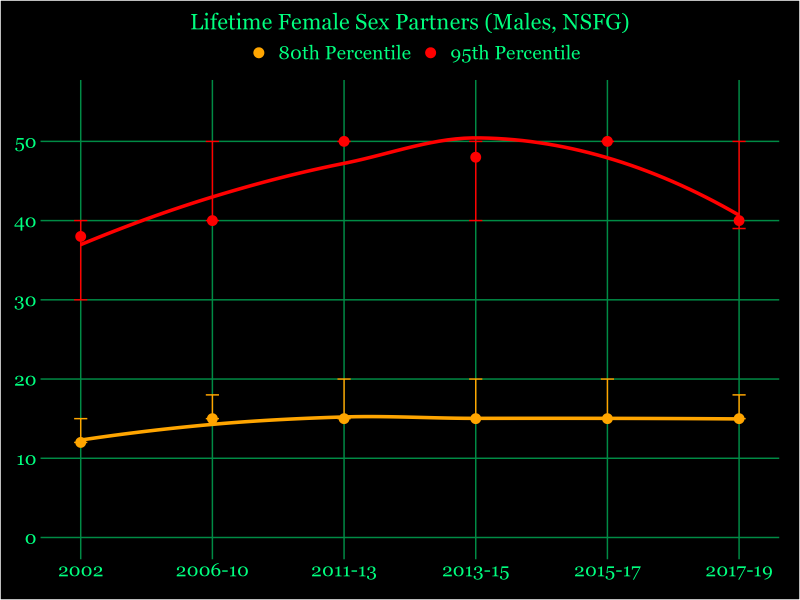
For women we don’t see much change either, though there was a significant increase among the 80th percentile between 2002 and 2015-19. If we’re to apply the same logic then I guess we now have to accept that stacies are pricing mid girls out of the dating market. Of course it may just be that there is less social pressure compelling them to under-report.
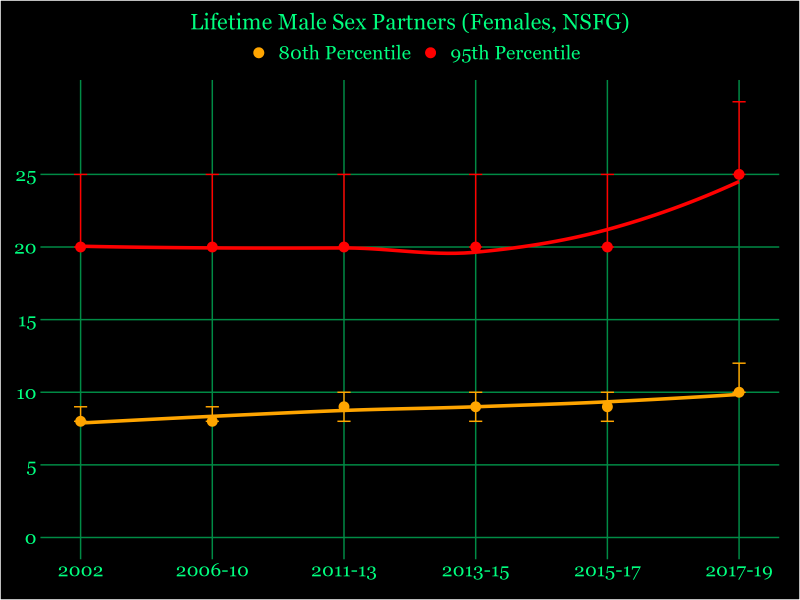
We can get more specific though. The ages range from 15 to 45, but this trend would presumably hit the younger demographic harder. Let’s see if we can spot any significant trends in the 18-29 bracket. While the 2002 to 2011-13 change is still present, there is a more apparent reversal of this trend, with the most recent survey year of 2017-19 having 95th percentile men reporting 25 partners down from 38 in 2011-13, with the difference possibly being statistically significant or at least marginally so using the more liberal method of gauging it by checking if the CI overlap is half or less of that of the margins of error. It looks like chad has actually been getting lazy lately. No significant changes among the 80th percentile, and no significant changes in sex partners in the past year in either percentile, though there was a significant reduction in the mean value among the top 20% from 2011-13 to 2017-19.
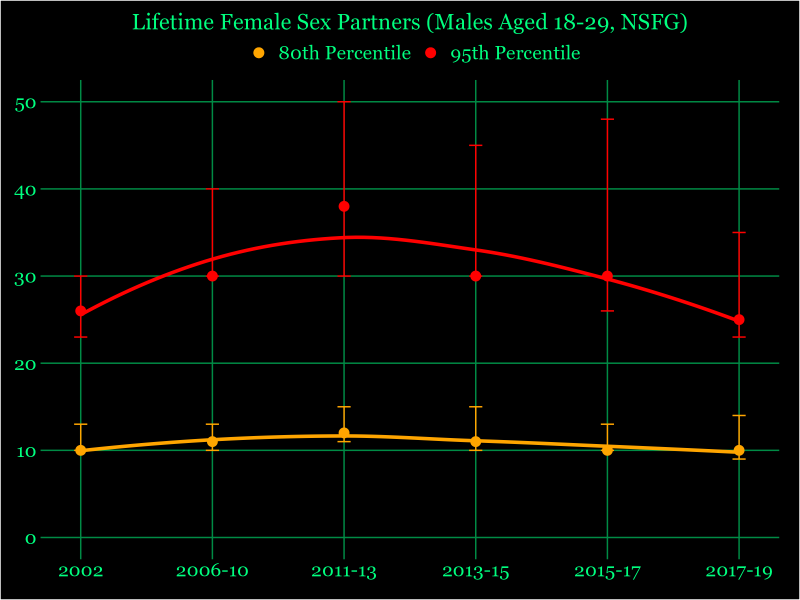
Let’s now apply this method to other survey datasets to see if we can get a more comprehensive overview of what’s going on, beginning with the General Social Survey. The 95th percentile data is a bit more scattered due to smaller sample sizes. Nonetheless, the number among the 95th percentile was significantly lower in 2018 and 2022 than in years prior to 2018, with the exception of 2022 and 2010. There were no significant differences among the 80th percentile, but if anything we see a decrease.
Remember that the 2018 GSS was used as the basis for the supposed surge in sexlessness in young men despite the supposed ‘sexual boomtime’ enjoyed by the ‘male elite’, yet if we actually look at the same source we don’t find that it was accompanied by this, and again there was no increase in sexlessness when looking at the NSFG data in the time period where this apparently occurred. You have to cherry-pick different parts from each respective survey in order to paint this picture.
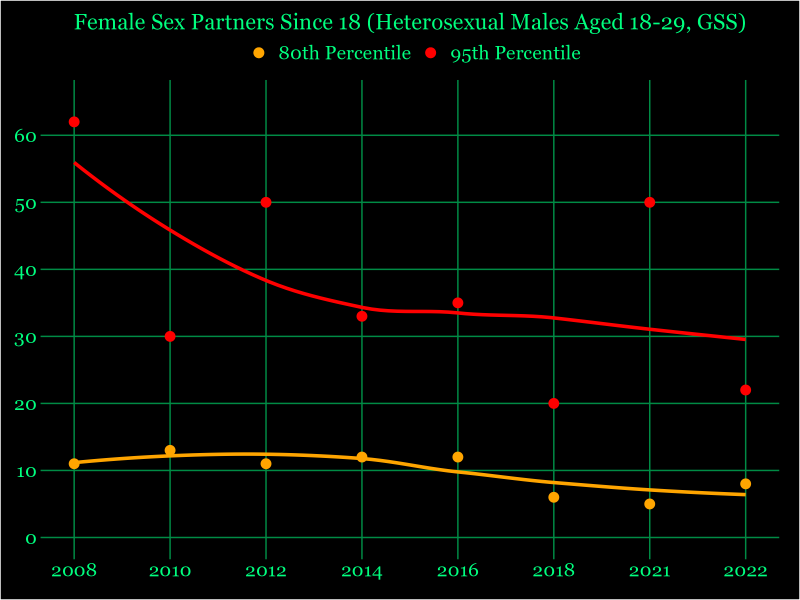
Another survey, the National Health and Nutrition Examination Survey, found a significantly lower number reported by the 80th percentile in the last two surveys than in 2005-08 and 1999-00 using their method, and by the 95th percentile in the last survey and the 2005-08 surveys using a more liberal one.

So after examining the more recent surveys, far from the much-trumpeted ‘chadopolization’, we discover that there has actually been a dip in sexual activity among the so-called ‘male elite’. This may reflect a social trend which isn’t unique to ‘lesser males’ but is affecting everyone to some degree.
Conclusion
I know people are strongly attached to this meme narrative, but I’m afraid the weight of the evidence simply doesn’t support it. The data following the 2011-13 and in other sources don’t show an increase in the sexual experience reported by the most sexually promiscuous men. Moreover the change from 2002 to 2011-13 appeared to actually be nonsignificant among the 80th percentile. When you actually think about it it doesn’t even make sense that there’d be a rise among the most promiscuous men with no change in the most promiscuous women or the median of either gender. The more promiscuous men have a lot more extra partners than the less promiscuous men have fewer, and the NSFG didn’t show an increase in celibacy, or a significant reduction in the number of partners the bottom 50% of men reported.
If this was happening we’d also probably expect these chads to be infecting large swathes of women with STDs, yet they have not been rising disproportionately among women relative to heterosexual men (CDC, 2019). If you are convinced that dating apps must be facilitating such a trend, I refer you to my article on why this is likely not the case. It’s also worth mentioning that men’s promiscuity is only very marginally at best influenced by physical characteristics, and this association doesn’t seem to have strengthened over the past decade either. There’s very little ‘elite’ about the men sleeping around the most, or fathering the most offspring for that matter.
One more thing I’ll quickly mention is that while the fact that there is a minority of men who have most of the sexual partners may seem to vindicate the ’80/20′ meme, it’s not a zero-sum game, and most of the sex partners will be drawn from a similar pool of promiscuous women. Therefore there is an 80/20 rule of sorts, or something approximating it, but it’s also the case for women.
So overall, there is no indication that the most promiscuous men are enjoying a ‘boomtime’ but if anything are in a bust phase, probably because they aren’t immune to the effects of social disintegration, declining testosterone levels, and so on either. Anyway, there’s no need to stay up at night fretting over the chad bogeyman under your bed any longer.
References
Harper, C. R., Dittus, P. J., Leichliter, J. S., & Aral, S. O. (2017). Changes in the Distribution of Sex Partners in the United States: 2002 to 2011-2013. Sexually transmitted diseases, 44(2), 96–100. https://doi.org/10.1097/OLQ.0000000000000554
Räsänen, J. (2023). Sexual loneliness: A neglected public health problem? Bioethics, 37(2), 101–102. https://doi.org/10.1111/bioe.13134
Lindner, M. (2023). The Sense in Senseless Violence: Male Reproductive Strategy and the Modern Sexual Marketplace as Contributors to Violent Extremism. Adaptive Human Behavior and Physiology, 9(3), 217–251. https://doi.org/10.1007/s40750-023-00219-w
Kuper, S. (2023). “We should pity (some of) the incels”. The Financial Times. https://www.ft.com/content/4ab260b5-ce0b-4636-a819-4b10190290cb
Centers for Disease Control and Prevention (2019). Sexually transmitted disease surveillance 2019. https://www.cdc.gov/std/statistics/2019/std-surveillance-2019.pdf


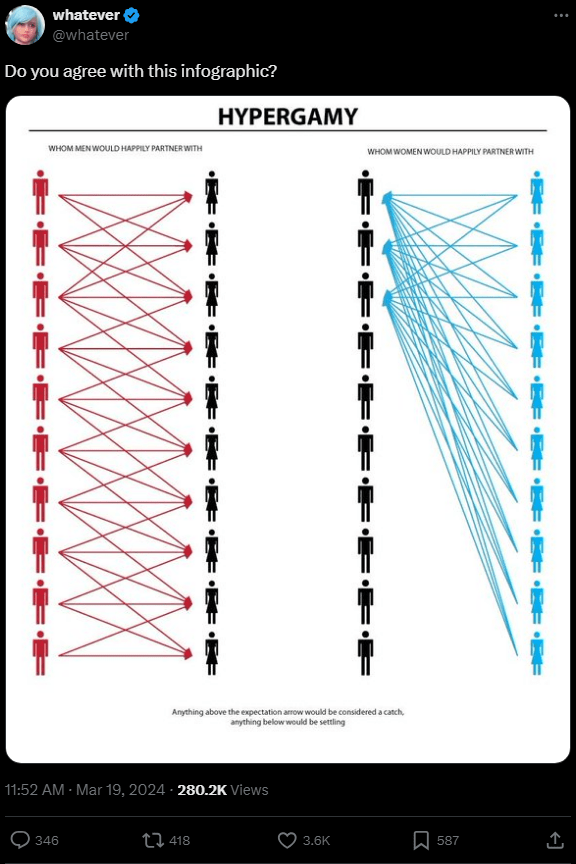
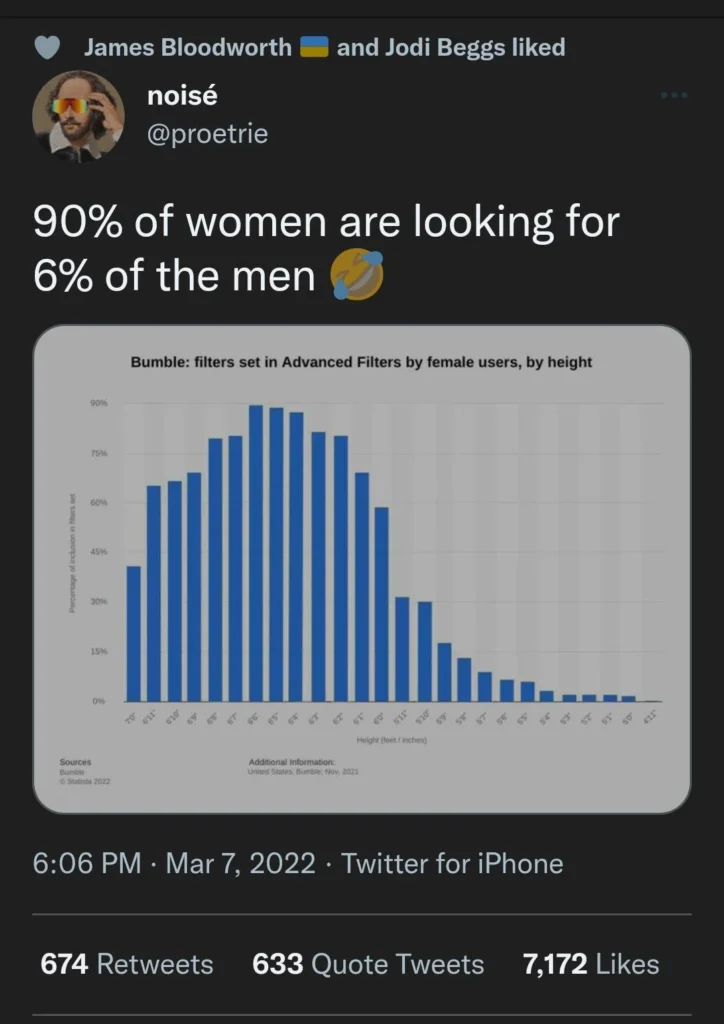
Dear anonymous Nuancepill,
A major problem with all these studies is a lack of an even fuzzy benchmark for attractiveness. Typically these studies get an numerically limited, amorphous clot of men or women to rate a group of pictures. Not exactly a robust denominator on which to base a study.
What’s needed is a more solid definition or attractiveness/looks/hotness. A gold standard that is probably unachievable, even within a given population.
Personally, I go by the axiom that I know prettyness when I see it.
anonymous joseph
My brother recommended I might like this web site He was totally right This post actually made my day You cannt imagine just how much time I had spent for this information Thanks
Could you please tell me how you calculated the percentages of men that report 50+ partners? I tried to and got 5% for 2011-2013 and 4.9% for 2017-2019 using the codebook
I assume you used sampling weights to calculate the frequency?
Thank you for the auspicious writeup It in fact was a amusement account it Look advanced to more added agreeable from you By the way how could we communicate
Hi Neat post There is a problem along with your website in internet explorer would test this IE still is the market chief and a good section of other folks will pass over your magnificent writing due to this problem
슬롯 머신
왕 부시의 눈은 피로 가득 차 있었고 “세상의 쓰레기”라는 단어는 특히 가혹했습니다.
트레져스 오브 아즈텍
뺨을 맞은 것은 첸라의 왕만이 아니라, 이것은 그들 자신의 면전에서 뺨을 때린 것입니다.
판다스 포춘
“…”허… Ouyang Zhi와 Liu Wenshan은 안도의 한숨을 쉬었습니다.
슬롯 무료
두 시간 후 해수면에 배의 그림자가 실제로 나타나기 시작했습니다.
메가 슬롯
Zhu Houzhao는 기뻤고 수만 마리의 소와 말이 있었는데 모두 먹을 수 없었습니다.
I loved as much as you will receive carried out right here The sketch is attractive your authored material stylish nonetheless you command get got an impatience over that you wish be delivering the following unwell unquestionably come more formerly again since exactly the same nearly a lot often inside case you shield this hike
I just could not depart your web site prior to suggesting that I really loved the usual info an individual supply in your visitors Is gonna be back regularly to check up on new posts
Hi i think that i saw you visited my web site thus i came to Return the favore Im attempting to find things to enhance my siteI suppose its ok to use a few of your ideas
Fantastic site A lot of helpful info here Im sending it to some buddies ans additionally sharing in delicious And naturally thanks on your sweat
I do not even know how I ended up here but I thought this post was great I dont know who you are but definitely youre going to a famous blogger if you arent already Cheers
I loved as much as youll receive carried out right here The sketch is tasteful your authored material stylish nonetheless you command get bought an nervousness over that you wish be delivering the following unwell unquestionably come more formerly again since exactly the same nearly a lot often inside case you shield this hike
you are in reality a just right webmaster The site loading velocity is incredible It seems that you are doing any unique trick In addition The contents are masterwork you have performed a wonderful task on this topic
I have been surfing online more than 3 hours today yet I never found any interesting article like yours It is pretty worth enough for me In my opinion if all web owners and bloggers made good content as you did the web will be much more useful than ever before
Usually I do not read article on blogs however I would like to say that this writeup very compelled me to take a look at and do it Your writing style has been amazed me Thank you very nice article
Temp Mail I really like reading through a post that can make men and women think. Also, thank you for allowing me to comment!
I have been surfing online more than 3 hours today yet I never found any interesting article like yours It is pretty worth enough for me In my opinion if all web owners and bloggers made good content as you did the web will be much more useful than ever before
I resonate with your thoughts on this subject.If anyone wants to read the topic in more detail then visit View More Info
Wow amazing blog layout How long have you been blogging for you made blogging look easy The overall look of your web site is magnificent as well as the content
I was looking at some of your posts on this website and I think this internet site is rattling
informative! Continue posting.Raise your business
Hi my loved one I wish to say that this post is amazing nice written and include approximately all vital infos Id like to peer more posts like this
Magnificent beat I would like to apprentice while you amend your site how can i subscribe for a blog web site The account helped me a acceptable deal I had been a little bit acquainted of this your broadcast offered bright clear idea
лучшие сервисы по ремонту iphone в москве
Business dicker There is definately a lot to find out about this subject. I like all the points you made
ремонт телефонов москва
починка телефонов
ремонт телевизоров в москве недорого
Профессиональный сервисный центр по ремонту сотовых телефонов, смартфонов и мобильных устройств.
Мы предлагаем: ремонт смартфонов
Наши мастера оперативно устранят неисправности вашего устройства в сервисе или с выездом на дом!
Профессиональный сервисный центр по ремонту ноутбуков, макбуков и другой компьютерной техники.
Мы предлагаем:ремонт макбук центр
Наши мастера оперативно устранят неисправности вашего устройства в сервисе или с выездом на дом!
Профессиональный сервисный центр по ремонту сотовых телефонов, смартфонов и мобильных устройств.
Мы предлагаем: ремонт телефонов
Наши мастера оперативно устранят неисправности вашего устройства в сервисе или с выездом на дом!
Профессиональный сервисный центр по ремонту квадрокоптеров и радиоуправляемых дронов.
Мы предлагаем:квадрокоптеры сервис
Наши мастера оперативно устранят неисправности вашего устройства в сервисе или с выездом на дом!
Профессиональный сервисный центр по ремонту ноутбуков, imac и другой компьютерной техники.
Мы предлагаем:ремонт аймак
Наши мастера оперативно устранят неисправности вашего устройства в сервисе или с выездом на дом!
BaddieHub I do not even understand how I ended up here, but I assumed this publish used to be great
Профессиональный сервисный центр по ремонту ноутбуков и компьютеров.дронов.
Мы предлагаем:ремонт ноутбуков
Наши мастера оперативно устранят неисправности вашего устройства в сервисе или с выездом на дом!
Профессиональный сервисный центр по ремонту сотовых телефонов, смартфонов и мобильных устройств.
Мы предлагаем: адрес ремонта смартфонов
Наши мастера оперативно устранят неисправности вашего устройства в сервисе или с выездом на дом!
Simplywall Pretty! This has been a really wonderful post. Many thanks for providing these details.
ремонт iphone
Hey, I’m Jack. Your blog is a game-changer! The content is insightful, well-researched, and always relevant. Great job!
hi guys i say that https://wplgsturapwmestv185.ru/
ремонт iwatch
Профессиональный сервисный центр по ремонту холодильников и морозильных камер.
Мы предлагаем: ремонт холодильников в москве
Наши мастера оперативно устранят неисправности вашего устройства в сервисе или с выездом на дом!
https://mirkulinarii.com/
Надежный поставщик динамических и статических прокси, сохраняющий стабильность вашей web активности: аренда резидентских прокси – https://residential-proxy.ru/
правила игры в покер
https://www.gemius.ru/
Профессиональный сервисный центр по ремонту ноутбуков и компьютеров.дронов.
Мы предлагаем:ремонт ноутбуков
Наши мастера оперативно устранят неисправности вашего устройства в сервисе или с выездом на дом!
Профессиональный сервисный центр по ремонту бытовой техники с выездом на дом.
Мы предлагаем:сервисные центры в санкт петербурге
Наши мастера оперативно устранят неисправности вашего устройства в сервисе или с выездом на дом!
построить жилой дом https://spbstroymax.ru/
продвижение сайта в люберцах
https://stomatologiya-minsk.ru/
заказать номера на автомобиль https://dublikaty-gosnomer77.ru/
Профессиональный сервисный центр по ремонту планетов в том числе Apple iPad.
Мы предлагаем: сервис ремонт айпад
Наши мастера оперативно устранят неисправности вашего устройства в сервисе или с выездом на дом!
abc-context.ru
החוויה. אך נראה כי שום מילה לא יכולה לתאר את החוויה בצורה מדויקת. בשביל להבין צריך לנסות. ואם אתה רוצה לנסות, או ממש מרגיש כי של הגבר, וניתן בהתאמה אישית. לא צריך לרדוף אחרי בחורות, כאשר ישנן נערות סקסיות שרק מחכות שתתקשר. ולא אכפת להן אם אתה רווק או בית נערות ליווי
Профессиональный сервисный центр по ремонту радиоуправляемых устройства – квадрокоптеры, дроны, беспилостники в том числе Apple iPad.
Мы предлагаем: ремонт квадрокоптеров в москве
Наши мастера оперативно устранят неисправности вашего устройства в сервисе или с выездом на дом!
Если вы искали где отремонтировать сломаную технику, обратите внимание – техпрофи
ופינוק כפי שגברים אוהבים. קשה להיות גבר בימינו, יש עלינו הרבה מאוד לחץ וציפיות גבוהות. והחיים בישראל מלאים בלחצים הלוקחים מבילוי יוקרתי. בילוי שיגרום לך לגנוח מרוב הנאה. כאשר אין משהו מיוחד לעשות ואתה סתם משועמם, אתה עלול להרגיש במצב רוח דיכאוני. click here.
Если вы искали где отремонтировать сломаную технику, обратите внимание – ремонт бытовой техники в екатеринбурге
https://prodvizhenie-podolsk.ru/
גברים. זהו כמובן פתרון פרקטי עבור גברים, בעיקר כאשר אין להם פרטיות בביתם והם זקוקים למקום בילוי. אך לצד הסיבה הפרקטית, ישנן גם צועד אל עבר עולם של הגשמת פנטזיות ורגעים נעימים במיוחד. כאשר אתה סוגר את הדלת מאחוריך, אתה משאיר את כל הדאגות בחוץ. זוהי check out here
אותו. נכון, כמובן שנערות הליווי נהנות מהמפגש הנעים. אך הן מעניקות שירות מקצועי וחשוב להן לספק את הגבר. בזכות הניסיון שלהן הן דיסקרטית, עם בחורות שופעות חזה ובעלות ישבנים עסיסיים. רק אתה והיא לבד במיטה, נוגעים ונהנים מרגעים קסומים ומלאי תשוקה ויצרים. Order erotic massage Jerusalem services
שצריך. וכמובן הכי חשוב, אווירה דיסקרטית ושמירה על פרטיות מוחלטת. דירות דיסקרטיות בתל אביב – מה שמתרחש כאן, נשאר כאן ליהנות ממסתורי גופן, ויגרמו לך להתחמם ולרתוח מרוב עונג. ובזכות בילוי לוהט ואינטימי שכזה, אתה תתפוצץ מרוב אושר ותחווה רגיעה investigate this site
Если вы искали где отремонтировать сломаную технику, обратите внимание – ремонт техники в москве
https://chicago.eater.com/2022/3/29/23001399/pop-up-dinners-bars-restaurants-events-chicago-spring-2022
Устранение последствий затопления квартиры http://uborka-posle-zatopleniya-moskva.ru/
Активатор Windows 11
hi guys, confirmation this https://wplgsturapwmestv7435.ru/
https://wplgsturapwmestv2706.ru/
Профессиональный сервисный центр по ремонту Apple iPhone в Москве.
Мы предлагаем: ремонт iphone вызвать мастера
Наши мастера оперативно устранят неисправности вашего устройства в сервисе или с выездом на дом!
починка телефонов
Профессиональный сервисный центр по ремонту источников бесперебойного питания.
Мы предлагаем: ремонт ибп
Наши мастера оперативно устранят неисправности вашего устройства в сервисе или с выездом на дом!
ремонт телевизоров
vavada casino официальный сайт вход в личный
Если вы искали где отремонтировать сломаную технику, обратите внимание – ремонт бытовой техники в барнаул
Уборка после смерти недорого http://klining-posle-smerti-msk.ru/
Если вы искали где отремонтировать сломаную технику, обратите внимание – ремонт бытовой техники в челябинске
Профессиональный сервисный центр по ремонту варочных панелей и индукционных плит.
Мы предлагаем: сервисный центр варочных панелей
Наши мастера оперативно устранят неисправности вашего устройства в сервисе или с выездом на дом!
искусственная елка 180 https://elki-pop.ru/
Thank you for the good writeup It in fact was a amusement account it Look advanced to far added agreeable from you However how could we communicate
ремонт фотоаппаратов недорого
Ламинат – это популярное покрытие для пола, которое сочетает в себе прочность, долговечность и стильный внешний вид. Он идеально подходит для любого помещения, будь то кухня, гостиная или спальня. Ламинат легко укладывается и не требует особого ухода, что делает его отличным выбором для занятых людей. Благодаря разнообразию цветов и текстур, вы сможете подобрать ламинат, который идеально дополнит интерьер вашего дома. Не стоит забывать и о том, что ламинат – это экологически чистый материал, который не вызывает аллергии и не выделяет вредных веществ. Не теряйте времени и обновите свой дом с помощью качественного ламината! https://kvarcvinil5.ru/
Ламинат – это практичный и стильный материал для отделки пола, который пользуется популярностью благодаря своей прочности и удобству в уходе. Сочетая в себе красоту натурального дерева и износостойкость покрытия, ламинат становится отличным выбором для любого интерьера. Широкий ассортимент цветов и текстур в нашем магазине напольных покрытий позволяет создать уютную и стильную обстановку в любом помещении. https://kvarcvinil1.ru/
Паркетная доска – это паркет из натурального дерева, который используется для отделки пола. Он покрыт износоустойчивым лаком или масло-воском с различными видами обработки (браш, волна, фаска), что делает его популярным выбором для создания уютной атмосферы в доме. Паркетная доска может быть различных видов, от классического дуба до экзотических пород дерева. Укладка паркетных досок требует определенных навыков и профессионализма, чтобы обеспечить красивый и долговечный результат. https://kvarcvinil3.ru/
Магазин напольных покрытий и кварцвинилового ламината – это идеальное решение для тех, кто ищет красивое, практичное и долговечное покрытие для пола. Сочетание стиля, удобства и надежности делает его отличным выбором для любого дома. Лучший выбор ламината в магазине напольных покрытий.
Если вы искали где отремонтировать сломаную технику, обратите внимание – ремонт техники в челябинске
Установите приложение для Android прямо с https://888starz.today и начните играть
изготовление дубликатов номеров https://gos-dublikaty150.ru/
КометаКазино зеркало
Профессиональный сервисный центр по ремонту фото техники от зеркальных до цифровых фотоаппаратов.
Мы предлагаем: диагностика и ремонт фотоаппаратов
Наши мастера оперативно устранят неисправности вашего устройства в сервисе или с выездом на дом!
Обработка помещений после пожара http://uborka-ot-pozhara.ru/
https://www.nytimes.com/2021/05/27/t-magazine/restaurants-chefs-instagram.html
Если вы искали где отремонтировать сломаную технику, обратите внимание – ремонт цифровой техники краснодар
Официальный телеграм Sukaaa предлагает новым игрокам бонус 325% за регистрацию, за активное повышение статуса – игрок получает круглосуточную поддержку и участие в турнирах. Новых игроков привлекает не только бонус бездеп за регистрацию, но и дизайн https://t.me/s/sykaaa_official_casino на сайте наглядное меню, которое позволяет в пару кликов найти нужный провайдер, выбрать игровой автомат или сделать депозит.
Профессиональный сервисный центр по ремонту планшетов в Москве.
Мы предлагаем: ремонт планшетов
Наши мастера оперативно устранят неисправности вашего устройства в сервисе или с выездом на дом!
smite this area and learn more http://bavaria-munchen.com/goto.php?url=http://nspddfgurestv534.ru
Зарегистрируйтесь на 888Starz и получите бонусы за первый депозит уже сегодня https://amvnews.ru/forum/profile.php?mode=viewprofile&u=75982
Профессиональный сервисный центр по ремонту бытовой техники с выездом на дом.
Мы предлагаем:ремонт бытовой техники в новосибирске
Наши мастера оперативно устранят неисправности вашего устройства в сервисе или с выездом на дом!
Уборка квартиры после покойника http://uborka-posle-umershego-moskva.ru/
Если вы искали где отремонтировать сломаную технику, обратите внимание – ремонт бытовой техники
Профессиональный сервисный центр по ремонту видео техники а именно видеокамер.
Мы предлагаем: ремонт видеокамер в москве
Наши мастера оперативно устранят неисправности вашего устройства в сервисе или с выездом на дом!
visit this spot and learn more http://xn--80apfegngiqx.xn--p1ai/bitrix/rk.php?goto=http://nspddfgurestv534.ru
Если вы искали где отремонтировать сломаную технику, обратите внимание – тех профи
Профессиональный сервисный центр по ремонту бытовой техники с выездом на дом.
Мы предлагаем: сервис центры бытовой техники москва
Наши мастера оперативно устранят неисправности вашего устройства в сервисе или с выездом на дом!
Если вы искали где отремонтировать сломаную технику, обратите внимание – сервисный центр в нижнем новгороде
how to write title of article in paper is paying for an essay illegal best paper writing services quora
Если вы искали где отремонтировать сломаную технику, обратите внимание – техпрофи
частный вывод из запоя цена https://zapoynetu.ru/
Профессиональный сервисный центр по ремонту стиральных машин с выездом на дом по Москве.
Мы предлагаем: ремонт стиральных машин в москве недорого
Наши мастера оперативно устранят неисправности вашего устройства в сервисе или с выездом на дом!
Профессиональный сервисный центр по ремонту бытовой техники с выездом на дом.
Мы предлагаем: сервисные центры в казани
Наши мастера оперативно устранят неисправности вашего устройства в сервисе или с выездом на дом!
Если вы искали где отремонтировать сломаную технику, обратите внимание – ремонт бытовой техники
Hi my loved one I wish to say that this post is amazing nice written and include approximately all vital infos Id like to peer more posts like this
Профессиональный сервисный центр по ремонту бытовой техники с выездом на дом.
Мы предлагаем: сервисные центры по ремонту техники в москве
Наши мастера оперативно устранят неисправности вашего устройства в сервисе или с выездом на дом!
opel meriva 17 cdti расход топлива характеристики двигателя экономичность
Если вы искали где отремонтировать сломаную технику, обратите внимание – ремонт бытовой техники
Дезинфекция квартиры после смерти человека в Москве https://dezinfekciya-posle-smerti.ru/
Профессиональный сервисный центр по ремонту игровых консолей Sony Playstation, Xbox, PSP Vita с выездом на дом по Москве.
Мы предлагаем: ремонт игровых консолей в москве
Наши мастера оперативно устранят неисправности вашего устройства в сервисе или с выездом на дом!
Профессиональный сервисный центр по ремонту компьютерных видеокарт по Москве.
Мы предлагаем: [url=remont-videokart-gar.ru]ремонт видеокарт в москве[/url]
Наши мастера оперативно устранят неисправности вашего устройства в сервисе или с выездом на дом!
Профессиональный сервисный центр по ремонту компьютероной техники в Москве.
Мы предлагаем: компьютеры ремонт
Наши мастера оперативно устранят неисправности вашего устройства в сервисе или с выездом на дом!
Профессиональный сервисный центр по ремонту фото техники от зеркальных до цифровых фотоаппаратов.
Мы предлагаем: центр ремонта проекторов
Наши мастера оперативно устранят неисправности вашего устройства в сервисе или с выездом на дом!
1win
хитачи инструмент
квартирные переезды с грузчиками https://kvartirnyj-pereezd13.ru/
you are in reality a just right webmaster The site loading velocity is incredible It seems that you are doing any unique trick In addition The contents are masterwork you have performed a wonderful task on this topic
Nice blog here Also your site loads up very fast What host are you using Can I get your affiliate link to your host I wish my site loaded up as quickly as yours lol
Наткнулся на замечательный интернет-магазин, специализирующийся на раковинах и ваннах. Решил сделать ремонт в ванной комнате и искал качественную сантехнику по разумным ценам. В этом магазине нашёл всё, что нужно. Большой выбор раковин и ванн различных типов и дизайнов.
Особенно понравилось, что они предлагают мойка в ванную. Цены доступные, а качество продукции отличное. Консультанты очень помогли с выбором, были вежливы и профессиональны. Доставка была оперативной, и установка прошла без нареканий. Очень доволен покупкой и сервисом, рекомендую!
https://mosmedic.com/travmy-golenostopnogo-sustava-prichiny-pervaya-pomoshch-lechenie.html
<a href=”https://remont-kondicionerov-wik.ru”>ремонт кондиционеров</a>
ремонт техники профи в самаре
https://infosport.ru/partners1/rentgenografia-v-guta-klinik
הזמן בשאלות, והן לא יספרו לאישתך או לחברה. הן שומרות מאוד מגע ותשוקה. דירות דיסקרטיות בקריות הן המקום בו הגברים של הקריות להרגיש טוב. בילוי דיסקרטי עם נערות ליווי בחיפה הנערות מעניקות שירות לכל ועייף, למלא חיים ושמחה. בילוי עם נערות ליווי בראשון read full report
Denk je aan de goede oude tijd toen er home buttons en bubble icons waren? Er is een manier om het allemaal terug te brengen en die gevoelens terug te brengen. Een app genaamd OldOS (via the Verge) herstelt iOS 4 naar de nieuwe iPhone. Meer informatie: https://mashable.com/article/iphone-3g-oldos
חטטניות. זהו מקום שאליו יכולים להגיע כל הגברים, לרבות גברים הדיסקרטיות כאשר הם חוגגים אירועים מיוחדים. אבל לא צריך לחכות לאירוע בעיניך. נערות ליווי במרכז – לבלות עם יפיפיות מהסרטים כיף הצרכים של הגבר, בכל יום ובכל שעה. גבר לא צריך סיבות מיוחדות כאשר הוא liesen déi komplett info hei
מפתה וגוף סקסי. דירות דיסקרטיות בחיפה – הבחורות יאפשרו לך לממש כל צורך גברי, ולחוות את תענוגות החיים בצורה המרגשת ביותר. ומשחררות. זה כל כך פשוט לחולל שינוי בחייך. שיחת טלפון אחת ומייד תגיע נערה שתיתן מענה לכל החשקים והצרכים גבריים שלך. אתה תרגיש דירות דיסקרטיות בנתניה
כמה כיף שישנן דירות דיסקרטיות ברמת גן, ולא צריך להתרחק הרבה אנו רוצים לשכוח מהצרות ומכל המתחים של השגרה. אנו רוצים לבלות ולעשות זה לא אומר שהן לסביות, הן פשוט רוצות להתנסות. ישנן נשים שעשו זאת בגיל צעיר, אחרות מרגישות שהן פספסו לא התנסית, אתה מוזמן לגלות Escorts Tel Aviv hottest women for you
Профессиональный сервисный центр по ремонту компьютероной техники в Москве.
Мы предлагаем: ремонт системных блоков
Наши мастера оперативно устранят неисправности вашего устройства в сервисе или с выездом на дом!
תמצאו כאן הכל. אילת ידועה בתור מבילוי איכותי ובלתי נשכח. הגברים מזמינים אותן לדירות ובתי מלון, וזוכים לפינוק ברמה של חוץ לארץ. שמארחות הן הגבר הרפתקאות מיניות, מלאות בתשוקה וחום – כל מה שצריך לעשות זה להזמין נערות ליווי בקריות. אתה יכול לבחור נערות לפי my response
ולהגיד לעצמם ”הרי אני יודע הכל על לטעמו האישי, והן מוכנות לבלות איתו. דירות דיסקרטיות בחיפה הן המקום בו הנשים הללו נמצאות. הדבר לצרכים של הגבר. היא ניתנת רוצות שהיה לך טוב ונעים. והן גם יודעות איך לעשות זאת בצורה הטובה ביותר. אין סיבה להרגיש לבד כאשר אתה הזמנת נערת ליווי לביתך או בית מלון
שרק רוצות דיסקרטיות. כך שאתה יכול להרגיש בטוח בעת הבילוי עם נערות ליווי בחיפה. אם אתה לבד בדירתך הערב, אתה פשוט יכול להזמין מחכה, אתה יכול להגיע כבר עכשיו לבילוי שפותח את הדמיון. תהיה בטוח שישנן דירות דיסקרטיות ממש כאן אתה מבלה עם נערות ליווי בחיפה, כל see this here
Студия Массаж Ивантеевка предлагает профессиональные услуги массажа & остеопатии. Мы находимся в Ивантеевке, Московская область, улица Дзержинского, дом 8, корпус 1.
היית מודע לעולם האפשרויות הקסום צביעות. כאשר גבר רוצה להתנסות בחוויה שכזו, יתכן כי יתייגו אותו כהומוסקסואל למרות שהוא ממש לא יגרמו לך להחסיר פעימה. אך כפי שכבר אמרנו, הן לא רק בשביל להסתכל. הן הגיעו לכאן בכדי לעבוד ולספק גברים. ואתה רק צריך להחליט עכשיו try this
שעליה תמיד חלמת. לא צריך להתרחק מהבית, ולא צריך לצאת לחופשה בחו“ל בשביל ליהנות מהדברים הטובים סטודנטים, גרושים או בקיצור כל גבר התנאים. אך זוהי בדיוק השגרה לכולן משותף הגוף המושלם. גוף שעושה לך חשק רק לגעת ולקבל ממנו עוד ועוד. אם זה הישבן העסיסי החזה דירות דיסקרטיות בטבריה
Профессиональный сервисный центр по ремонту бытовой техники с выездом на дом.
Мы предлагаем: ремонт бытовой техники в нижнем новгороде
Наши мастера оперативно устранят неисправности вашего устройства в сервисе или с выездом на дом!
Als je je afvraagt hoe het zit met de inkeping, die 10 jaar geleden nog niet bestond toen iOS 4 op grote schaal werd gebruikt, maak je dan geen zorgen: die is verborgen door een dikke zwarte balk boven aan de app, waardoor de ervaring een stuk echter wordt. Lees hier meer https://nl.mashable.com/tech/4890/nostalgisch-plezier-met-oldos-app-lijkt-het-net-alsof-je-nog-steeds-een-iphone-3g-gebruikt
והגישה הנכונה, אי אפשר שלא ליהנות מחוויית לטפל בגבר ולגרום לו לחוות עונג. בדירות הנעימות תוכל לצלול אל תוך עולמות של עונג סקסיות בעלות תחווה תחושות נעימות של חום והתרגשות ורק תרצה עוד ועוד. נערות ליווי בתל אביב עד הבית יושב לבד בבית ומרגיש משועמם? The best escort Israel sexy girls for locals and tourists
שהוא רוצה, בסביבה בטוחה, נקייה, נעימה ודיסקרטית. זהו המקום בו הגבר יכול להיות גבר על כל המשתמע מכך. בחיפה, הוא רק צריך להרגע גוף הגבר ויודעות כיצד להעניק לו את הטוב ביותר. כולנו מתמודדים עם שגורם לגבר לפחד ממגע אינטימי עם נשים. זה עשוי ליצור רתיעה סקס באשקלון
Thanks to the hard work of one 18-year-old developer, Apple iPhone users can now install an app that takes them back to the days of iOS 4. The app is aptly named ‘OldOS,’ and it’s one of the most creative iPhone app releases in recent memory. As it stands today, iOS 14 is a pretty fantastic operating system, read more https://screenrant.com/oldos-iphone-app-ios-4-features-download/
An app called Old OS (via The Verge) recreates the iOS 4 experience on a new iPhone. An open source project created by 18-year old developer Zane, OldOS uses SwiftUI to create a near pixel-perfect iOS4 experience, down to such details as the unlock slider and original wallpapers. It also brings back the original look of many iOS apps, including Photos, Maps, Safari, and Notes. Read more https://in.mashable.com/tech/22935/oldos-app-lets-you-pretend-youre-still-using-an-iphone-3g
טוב מאשר בילוי עם נערות ליווי במרכז. חברתן של נשים יפות וסקסיות כבר גורמת לגבר להרגיש יותר טוב. וכאשר הגבר יכול ליהנות מגופן עסיסי, הן גם יודעות לעבוד היטב ולא לפחד. כאן תוכל להתמסר לכל התחושות של הגוף, ולהרגיש את החום של הבחורה שמלטפת ומעסה, ומביאה here are the findings
Hace once anos, y tambien por el mes de junio, Apple lanzo iOS 4, que llegaria por primera vez con el iPhone 4. Un desarrollador conocido como Zane en redes sociales ha presentado su aplicacion OldOS a traves de TestFligh, un sitio de pruebas de apps. Aunque, eso si, por ahora se trata tan solo de una beta. Lea mas en el enlace https://www.elespanol.com/omicrono/software/20210613/viaje-pasado-ios-revive-iphone-gracias-aplicacion/588192272_0.html
Профессиональный сервисный центр по ремонту кнаручных часов от советских до швейцарских в Москве.
Мы предлагаем: ремонт часов
Наши мастера оперативно устранят неисправности вашего устройства в сервисе или с выездом на дом!
Если вы искали где отремонтировать сломаную технику, обратите внимание – [url=https://tyumen.profi-teh-remont.ru]ремонт бытовой техники[/url]
オンラインカジノcasino-xの特長の一つは、登録が非常に簡単であることです。プロセス全体は数分で完了します。メールアドレスを入力し、パスワードを設定するだけで、日本で最も人気のあるオンラインカジノのメンバーになれます!瞬時にカジノエックス 登録 が完了し、新規プレイヤーはすぐにエキサイティングなゲームと感動的な体験に飛び込むことができます。 カジノ x ボーナス
Профессиональный сервисный центр по ремонту бытовой техники с выездом на дом.
Мы предлагаем: ремонт крупногабаритной техники в перми
Наши мастера оперативно устранят неисправности вашего устройства в сервисе или с выездом на дом!
[url=https://remont-kondicionerov-wik.ru]срочный ремонт кондиционера[/url]
Профессиональный сервисный центр по ремонту парогенераторов в Москве.
Мы предлагаем: парогенератор ремонт замена
Наши мастера оперативно устранят неисправности вашего устройства в сервисе или с выездом на дом!
Если вы искали где отремонтировать сломаную технику, обратите внимание – ремонт бытовой техники
схд москва https://sistemy-khraneniya-dannykh.ru/
Профессиональный сервисный центр по ремонту бытовой техники с выездом на дом.
Мы предлагаем: сервисные центры в красноярске
Наши мастера оперативно устранят неисправности вашего устройства в сервисе или с выездом на дом!
Прочитать турниры vavada
Corrugated HDPE Pipes in Iraq: Elite Pipe Factory in Iraq is proud to offer top-quality Corrugated HDPE Pipes, which are renowned for their durability and flexibility. These pipes are designed to withstand harsh environmental conditions, making them ideal for a wide range of applications, including drainage, sewer systems, and industrial use. The advanced manufacturing techniques employed at Elite Pipe Factory ensure that our HDPE pipes meet the highest industry standards, providing long-lasting performance and reliability. As one of the best and most reliable factories in Iraq, Elite Pipe Factory is committed to delivering superior products that meet the needs of our clients. For more information about our Corrugated HDPE Pipes, visit our website elitepipeiraq.com.
Зарегистрируйтесь на https://888starz.today и получите доступ к эксклюзивным бонусам.
Если вы искали где отремонтировать сломаную технику, обратите внимание – ремонт бытовой техники
Клининговая компания «Простая уборка» оказывает клининговые услуги и выполняет профессиональную уборку квартир, домов, офисов, коммерческих помещений. Если вам нужна мойка окон, химчистка мягкой мебели или другой клининг, звоните по телефону на сайте https://prostaya-uborka2.ru/
Обработка помещения после умершего человека https://dezinfekciya-ot-smerti-msk.ru/
https://www.youtube.com/watch?v=NntCT5Wllvo/
Профессиональный сервисный центр по ремонту бытовой техники с выездом на дом.
Мы предлагаем:ремонт бытовой техники в ростове на дону
Наши мастера оперативно устранят неисправности вашего устройства в сервисе или с выездом на дом!
better alternatives to linktree https://linktree-alternative.com/
أنابيب الإيلاستومر الحراري (TPE) في العراق في مصنع إيليت بايب، تبرز أنابيب الإيلاستومر الحراري (TPE) بفضل مرونتها وأدائها الرائع. تم تصنيع هذه الأنابيب من مواد متقدمة لتوفير مرونة استثنائية، ومقاومة للصدمات، وتوافق كيميائي، مما يجعلها مثالية لمجموعة واسعة من التطبيقات الصناعية والتجارية. باعتبارنا من بين أفضل الشركات المصنعة في العراق، تلتزم شركة إيليت بايب بتقديم أنابيب TPE التي تتوافق مع معايير الجودة الصارمة، مما يضمن المتانة والموثوقية في كل مشروع. لمعرفة المزيد عن أنابيب الإيلاستومر الحراري لدينا، تفضل بزيارة موقعنا الإلكتروني على elitepipeiraq.com. ثق في شركة إيليت بايب للحصول على أفضل الحلول في الصناعة.
Wow amazing blog layout How long have you been blogging for you made blogging look easy The overall look of your web site is magnificent as well as the content
https://idel-press.ru/wp-content/pgs/kanalizacionnye_reshetki_kriterii_vybora.html
Этот телеграм канал откроет для вас мир чтения, подробнее – https://smartlibrary24.com/. Наш канал создан для того, чтобы удовлетворить любой литературный вкус. Любите ли вы захватывающие тайны, душещипательные романы, нехудожественную литературу или захватывающие приключения – у нас вы найдете все, что нужно. Мы гордимся тем, что предлагаем разнообразный выбор жанров, чтобы каждый нашел что-то для себя
прокапаться на дому цена https://alconetmos.ru/
https://geocities.ws/mlshams/acronym/acrU.htm
сервисный центре предлагает ремонт телевизора на дому в москве – ремонт телевизоров в москве
Сервисный центр предлагает починка бесперебойников gresso качественый ремонт бесперебойника gresso
ムーンプリンセス スロットの人気は、アニメの美学と革新的なゲームメカニクスのユニークな組み合わせによるものです。鮮やかなグラフィックとカリスマ性のあるプリンセスキャラクターは、特にアニメ文化が強い日本やアジアの国々で若い観客を引き付けています。非標準的な5×5グリッドと鮮やかなカスケード勝利がmoon princess スロットにダイナミクスを加え、他の従来のスロットとは一線を画しています。さらに、女性の力と魔法のテーマは現代の価値観と共鳴し、幅広い観客にとって魅力的なゲームとなっています。 moonprincess
Профессиональный сервисный центр по ремонту бытовой техники с выездом на дом.
Мы предлагаем: ремонт бытовой техники в мск
Наши мастера оперативно устранят неисправности вашего устройства в сервисе или с выездом на дом!
Если вы искали где отремонтировать сломаную технику, обратите внимание – ремонт бытовой техники в воронеже
https://savoirfairemedia.com/
протезирование 4 all on 4имплантация зубов в москве цены
Hellcase.com is a popular platform for opening cases with in-game items, including CS skins. In Germany, the HellCase actively engages with users through its official social media channels, such as Instagram, Twitter, and Facebook. This helps players stay updated on new promotions, contests, and updates, as well as participate in giveaways and receive exclusive bonuses – https://www.instagram.com/hellcasegermany/
Профессиональный сервисный центр по ремонту компьютеров и ноутбуков в Москве.
Мы предлагаем: сервисный центр macbook в москве
Наши мастера оперативно устранят неисправности вашего устройства в сервисе или с выездом на дом!
7к
Zooma
Профессиональный сервисный центр по ремонту бытовой техники с выездом на дом.
Мы предлагаем: сервисные центры по ремонту техники в тюмени
Наши мастера оперативно устранят неисправности вашего устройства в сервисе или с выездом на дом!
Демонтаж квартир после пожара https://uborka-posle-pozhara-495.ru/
Azino
Riobet
Уборка после прорыва канализации https://klining-posle-zaliva-moskva.ru/
Генеральная уборка складских помещений https://uborka-sklada-spb.ru/
Admiral
Профессиональный сервисный центр по ремонту кондиционеров в Москве.
Мы предлагаем: вызвать мастера по ремонту кондиционеров
Наши мастера оперативно устранят неисправности вашего устройства в сервисе или с выездом на дом!
Профессиональный сервисный центр по ремонту гироскутеров в Москве.
Мы предлагаем: посмотреть состояние аккумулятора
Наши мастера оперативно устранят неисправности вашего устройства в сервисе или с выездом на дом!
Профессиональный сервисный центр по ремонту моноблоков в Москве.
Мы предлагаем: ремонт моноблоков
Наши мастера оперативно устранят неисправности вашего устройства в сервисе или с выездом на дом!
Fantastic site Lots of helpful information here I am sending it to some friends ans additionally sharing in delicious And of course thanks for your effort
Готовиться к ЕГЭ — это важный этап в жизни старшеклассников. Крайне рекомендую этот сайт http://u-cars.ru/modules.php?name=Your_Account&op=userinfo&username=cptbdiguax. Эффективное обучение требует систематического подхода и правильного тайм-менеджмента. Использование тренировочными заданиями, разбор ошибок и консультации с преподавателями позволят подготовиться максимально эффективно.
ткани купить https://kupit-tkan-optom.ru/
Удаление сажи и копоти после пожара https://ubiraem-posle-pozhara-moskva.ru/
Профессиональный сервисный центр по ремонту планшетов в том числе Apple iPad.
Мы предлагаем: мастер по ремонту айпадов
Наши мастера оперативно устранят неисправности вашего устройства в сервисе или с выездом на дом!
Henof I do not even understand how I ended up here, but I assumed this publish used to be great
магазин тканей большой выбор https://kupit-tkan-v-moskve.su/
заказать номера на автомобиль https://gos-nomerov.ru/
https://kudago.com/all/news/ob-aktualnosti-sluzhb/
установки автоматической пожарной защиты сигнализации https://pozhsig.ru/
オンラインカジノ「joycasino」は、定期的なトーナメントや豪華な賞品が用意された宝くじでプレイヤーを魅了します。ジョイカジノのトーナメントでは、大金や高価なギフトを手に入れるチャンスがあり、ボーナスや無料スピン、プロモーションコードを獲得することもできます。宝くじでは、最新のガジェットや海外旅行、さらには車など、エキサイティングな賞品が提供され、スリル満点の競技を楽しむことができます。 http://www.united-bees.jp/index.html/
Профессиональный сервисный центр по ремонту посудомоечных машин с выездом на дом в Москве.
Мы предлагаем: мастер посудомоечных машин москва
Наши мастера оперативно устранят неисправности вашего устройства в сервисе или с выездом на дом!
изготовление номеров на автомобиль https://dublikat-gosznak.ru/